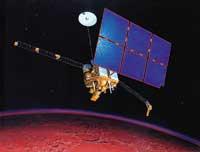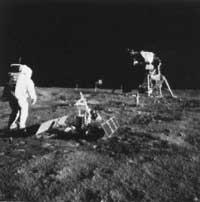Heartbeat to the Moon
2000/09/01 Kortabarria Olabarria, Beñardo - Elhuyar Zientzia Iturria: Elhuyar aldizkaria
The space race with Sputnik was in the first pedals of the last decade. The most memorable moments of the race came in the 1960s. With shots and blows, the competition was constant. To realize, just take a look at the facts: Yuri Gagarin, the first man launched into space, was the hero of the time in the Soviet Union. He had that honor (1961) and died eight years after a plane crash. First satellite television images, thanks to the satellite Telstar (1962). The American probe Mariner 2 approached the surroundings of Artizar (1962). Valentina Tereshkova, the first woman to arrive in space (1963). Gemini 1, first of the Gemini project, set off and tested the technology for the Apollo project that reached the Moon (1964). The Mariner 4 probe departed from Earth with the goal of Mars and arrived the following year. He took out the first nearby images of Mars (1965). Sending Pioneer probes into space to investigate the Sun (1965). Venera sent the probe of 3 Soviets into space to Venus. It came the following year (1965). The Surveyor 1 probe reached the Moon and sent television images to Earth (1965). Soviet astronaut Alexei Leonov made his first space march (1965). The Soviet spacecraft Lunik IX reached the Moon (1966). The Surveyor 5 probe performed the first chemical studies of the Moon (1967). Vladimir Komarov, with the spacecraft Soiuz 1, first man dead in space (1967). The Mariner 6 probe was introduced into the orbit of Mars (1969). The ship Soiuz 4 was launched into space and the next day Soiuz 5. El primer trasiego espacial (1969). The Russian spacecraft Soiuz 6, 7 and 8 were placed simultaneously in the Earth's orbit (1969). And finally, the feat for the Americans to climb to the highest podium of that race: Neil Armstrong and Buzz Aldrin reached the Moon in the Apollo XI spacecraft. For the first time man was on another planet. Everyone was excited about the arrival on the Moon, which aired its images on television. Shortly after, Charles Conrad and Alan Bean arrived on the Moon with Apollo XII. They were the third and fourth who stepped on the Moon. However, two months earlier, the Apollo X spacecraft was very close to the Moon and found that it was technically possible to land on it (1969). In two words, there was the most significant and remembered space adventure of all time.
Space research in this decade had a great speed - just ten years after the takeoff of Earth to the Moon - but in science it was not the only field that advanced. In medicine, for example, organ transplants advanced greatly. As for kidney transplants, in 1963 the surgeon Guy Alexandre performed the first transplant in Lovainan in concept of brain death. The kidney receptor died a month later. The following year, in 1964, the same surgeon performs a similar second transplant. The transplanted kidney played its role for six years. In the same decade, Swede Nils Alwall invented an artificial kidney. Currently, kidney receptors have no drawback in performing a normal life. The first liver transplant among humans was also performed in 1963 by surgeon Thomas Starzl. A child who died from a tumor was removed from his heart and placed in another three years. He survived five hours. Two months later, the same surgeon operated liver transplant among adults and the recipient died at 22 days. The issue of transplants became increasingly important, but what really made the topic socialize was heart transplant. In 1967, in the South African city of Cape Town, Dr. Christian Barnard performed the first heart transplant. The heart donor was a young woman who suffered an accident and broke her brain. A 54-year-old man received that heart. The intervention was fine. Ten days after receiving the heart, the patient was able to walk through the hospital room. However, he died two weeks after pneumonia. A month later Christian Barnard performed a second heart transplant. This second recipient was more fortunate than the first, as he lived a little over a year and a half. However, after breaking the limits that organs of the body can have, with organ transplants a new era for medicine was opened.
Although the trampling of the Moon by humans and the beginning of organ transplantation marked the scientific activity of the decade, these were not the only events:
- 1960. The Batiscafo Trieste reached the bottom of the Pacific, after descending 11 kilometers.
- 1960. The first transistorized television.
- 1960. Triton, the submarine, went around the world.
- 1960. American endocrinologist Gregory Pincus invented the hair dryer.
- 1960. Physicist Theodore Maiman invented the first useful laser.
- 1961. The entire electronic circuit was integrated into a single silicon chip, i.e. transistors, resistors, diodes, capacitors... were integrated into a single piece of semiconductor material. The RTL (Resistor-Transistor Logic) was devised by Robert Noyce of the Fairchild Camera and Technology Corporation. As you can see in the next decade, this meant the revolution of microelectronics and industrial computer production.
- 1961. The Swedes Per Oscar Persson and Goran Lundhal invented the Flofreez system to freeze food, so that in the freezing process vegetables do not mix.
- 1961. IBM pulled out a new typewriter, instead of traditional sticks, with a sphere of fonts.
- 1962. Polish mathematician Benoit Mandelbrot proposed the concept of fractal to understand the organization of the structures of Nature.
- 1964. IBM invented a typewriter with memory based on magnetic tape. Before printing I had the option to correct the errors and could make as many copies as necessary.
- 1964. Opening of the first high-speed train for travelers for the Osaka-Tokyo route.
- 1965. Physicists Arno Penzias and Robert Wilson discovered the microwave radiation from the universe.
- 1965. Stephanie Kowlek invented a tough kevlar material. Initially it was mainly used in anti-whale garments.
- 1966. Francis Chichester, 64, turned to Earth in a balloon.
- 1967. Seiko House released a quartz watch.
- 1967. A group of American biologists performed DNA synthesis in a trial. - 1967. The BBC began broadcasting in color.
- 1968. Start using epidural anesthesia to prevent labor pains.
- 1968. A laser knife was invented for brain operations.
- 1968. First scanning electron microscope.
- 1968. Intel launched the first high-density chip with high memory capacity.
- 1968. The researcher Robert Edwards managed to fertilize the human oculum outside the uterus.
- 1969. The U.S. defense department launched the Internet pioneer Arpanet network.
- 1969. Physicist Murray Gell-Mann discovered that neutrons and protons are made up of quarks. According to recent studies, there are only six families of quarks.

Gai honi buruzko eduki gehiago
Elhuyarrek garatutako teknologia





